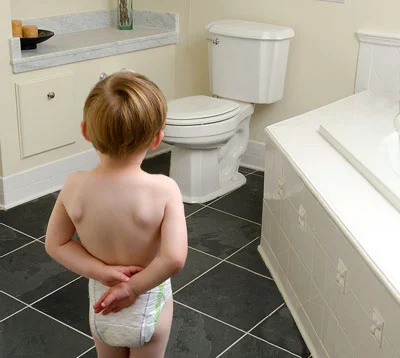Seven Steps to Toilet Learning Success

Part One:
I will never forget the day my daughter came running into the kitchen to announce – “I have to go potty.” That was it. From that point forward she rarely if ever had an accident. To an outsider that announcement may have seemed almost miraculous. The reality however, is that preceding that “moment” were months of teaching, practicing and most importantly nerve and muscle development.
Toilet learning – you can lead a child to the toilet, but you can’t make her go.
You can however, help her understand the concepts of wet and dry, create a toileting routine, practice using the “equipment” needed for toileting and patiently wait for signs of development that your child has the bladder and bowel control to be finished with diapers. Every child will follow his or her own schedule, but here are a few steps you can take to make the process as natural as learning to walk. And a few hints for what to do when you are beginning to doubt it will ever happen.
Steps to toilet learning:
1. Work Together
Toileting, like walking is a developmental task and like walking it is not a linear process. Think for a minute about walking. Your child learns to stand, long before she takes a step. One day she takes that step, maybe even several steps but then decides to crawl again for awhile. You don’t get angry that she’s crawling when you know she is capable of walking. You simply accept that she’s not quite comfortable yet, and recognize that soon she will choose to walk. One day she does.
Toilet learning is the same. Your role is to be the coach offering support, encouragement and opportunities to practice. Accepting that your child is the one who will ultimately show you when she’s ready. The challenge is that when she reaches the point of being dry several days in a row and then has an accident or urinates in the toilet, but insists she needs a diaper to poop, it’s difficult not to get frustrated. You may fear “sliding back” but if you push too hard toileting will become a power struggle that you will lose. What is a natural process can become one in which your child begins to “hold” or develop other physical and behavioral problems. You don’t want to go there. So as you go through the process remind yourself learning to toilet is like learning to walk. You are the guide. Your child sets the pace.
2. Understand development
There are three stages to toilet learning.
A. Your child is able to tell you AFTER she’s urinated or had a bowel movement that she has gone.
B. Your child is able to tell you she’s going.
C. Your child is able to tell you she needs to go.
At points A and B it’s easy to get irritated thinking your child is intentionally telling you when it’s too late to get her to the toilet. But this is not the case. Her nerve development is such that initially she cannot sense the need to go – she can only tell you she went. Soon she will be able to tell you she’s going. Finally she’ll have the nerve and muscle development to tell you she has to go! Each step is cause for celebration. Typically children gain bladder and bowel control between 2.5 and 3.5 years of age. Usually bladder control occurs before bowel control. Know too your child’s normal pattern. Some children may have several bowel movements every day. While others only pass a movement every two to three days – this is normal for them and not a cause for concern. Avoid beginning this process if in near future you are expecting a new baby or moving. Stress affects the elimination process making bladder and bowel control more difficult.
3. Build your child’s vocabulary and understanding of concepts
This is wet and uncomfortable. This is dry, clean and comfy. Toilet learning begins with conversations during diapering. Whenever you change your child – even if she is only 5 months old - talk about the fact that the diaper you are removing is wet. Let her hold the fresh one you’ll be putting on her, explaining it is dry and will feel good. Watch for signs that she is having a bowel movement. Her face may get red. She may squat. When you see these actions say to her, “You are going poop. Poop is coming out of your body. Doing so teaches her what is meant by pooping and what it feels like. If you haven’t had these discussions earlier, begin them now. She has to have the words and understanding to communicate the “sense” of getting wet or having a bowel movement.
4. Establish a diapering/toileting routine
When your child awakens in the morning, immediately change her diaper, rather than allowing her to play. If she’s not wet, announce, “You are dry.” If she is walking you will add, “Do you want to try sitting on the potty?” Or, “You are dry. It’s time to try the potty. If your child is resistant you can gently nudge her by saying, “Oh, you don’t want to try this time. Maybe next time you’ll want to try.” You are not expecting performance at this point in time. You are simply teaching her that when she wakes, she will toilet. She’s also learning how it feels to sit on the potty and how it works. If you do this long before she might actually be ready for bladder control she’s still in a stage of exploring her world. Sitting on the potty is fun – not a wrestling match. In order to avoid a power struggle you can switch her attention by asking, “Do you want me to count to five or twenty while you try?” Offer her books to look at. Sit and talk with her. Give her time to relax and see what happens. If she eliminates give her the words – “You are going.” Or, “You are peeing.” Whatever you are comfortable saying. If after several minutes of sitting she does not eliminate put her diaper back on. Practice is finished until later in the morning when you will stop to diaper/toilet again. Make diapering/toileting part of your routine after waking and eating and before going out. Then it will be second nature for her to stop and try when she’s actually using the toilet. Be sure to say, “Great try,” even if nothing “happened.”
5. Practice using the equipment
The toilet – especially those that flush automatically can be frightening to a child. If your child is uncomfortable with a toilet, break the process down into tiny steps. Make it easy for her to be successful. You might simply “look” at the toilet, then step closer to the toilet. Once you are close she can lift or lower the lid then try flushing it. These actions can be followed with sitting on the toilet with clothing on. Once your child is comfortable she can sit on the toilet with pants down. Make certain there is a stool to rest her feet on so that she is comfortable. In public bathrooms place your hand over the sensor or carry a pad of sticky notes. Place one over the sensor so that it does not “flush” before your child is ready. Allow her opportunities to practice pulling up and down pants. Purchase clothing that is easy to remove and put back on so she can be successful.
6. Switch to “big boy/girl pants” only after your child is able to tell you she needs to go
There’s nothing more frustrating than watching your child urinate on the kitchen floor because she could not hold it. Avoid frustrating yourself and your child by waiting until her nerve and muscle development are sensitive enough to forewarn her she needs to go. Expect that one day she may ask for a diaper to poop and the next day choose to sit on the potty for her bowel movement. Shifting back and forth is normal just like taking a few steps and then dropping to crawl across a room is normal. If your child is new to being dry continue to give her a choice. “Do you want a diaper or panties?” “Do you want to use the toilet or to have a diaper?” Remember you are working together. You do not want to be rigid, nor do you want to be tied to an outcome. This is a process which your child has control over. You are the guide. But she has the power.
7. Expect a point of resistance
It’s normal for a child to learn to use the toilet then suddenly decide she does not want to do so. When the moment strikes, or if you have been working with her and she is now 3.5 years or older but has not yet “tried,” it’s time to use a picture or a visual to prepare her that starting on this day – she’ll need to try. She doesn't have to go, but she does have to try. In order to make this happen, bring out the rewards. Lynn and I rarely use rewards but learning a new skill sometimes takes a bit of an incentive. A “reward” can be as simple as one M&M for urinating in the potty and 3 M&M’s for a bowel movement. If chocolate is not something you want to use, electronics may be even more effective. Ban electronic use – except when your child is sitting on the potty trying. The reason for this is that the distraction can allow her to push past any fears she has, and keep her on the toilet long enough to relax and get results. If she tries and does not go, tell her, “Good try!”
Used together these steps can gently nudge your child toward toileting competence with little resistance. Begin them early recognizing that you are teaching the process NOT yet expecting any results. Doing so can lead to that seemingly “miraculous moment” when everything comes together. The nerve and muscle development are complete and your child is familiar with all of the components to the toileting process. Only you will know about the months of conversations and practice sessions that came before this “moment” when your child ran in the door announcing, “I gotta go!”
If despite following these steps you are experiencing major resistance or no success and your child is 3.5 or older don’t despair. We’ll address these challenges in the next blog. You too can be successful.
Display All Posts
Search by Topic:
Popular Posts:
- When your child yells at you: Expecting and Coaching respectful behavior
- 5 Tips to Stop the 'Strike out Tantrums:' Hitting, Biting, Kicking and Name-calling
- Why is my child suddenly clingy?
- Ten Steps to a Peaceful Bedtime for Your Spirited Child
- When Your Child’s Meltdowns are Ruining Vacation






